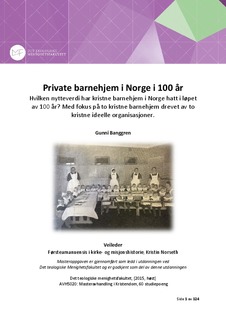Private barnehjem i Norge i 100 år. Hvilken nytteverdi har kristne barnehjem i Norge hatt i løpet av 100 år? Med fokus på to kristne barnehjem drevet av to kristne ideelle organisasjoner
Abstract
This MA-thesis is a study of private orphanage in Norway in a 100-year perspective. With focus on two christian orphanages ran by two christian non-profit organizations, this study will examine what value christian orphanages has had in Norway during the last 100 years, and how they have been conducted. This thesis, which is the first of its kind, is based predominantly on primary sources found in the Norwegian National Archives (Riksarkivet) and in private archives. The main questions have been as follows: what internal and external factors have affected the work, and what changes have characterized the work in the 100 years they have existed? This study is a historical thesis, which means it intends to say something about the actual reality by reconstructing the past. The material has been approached in an inductive way to see patterns in diversity of data. Anne Lise Seips Welfare triangle (Velferdstrekant) was an important tool when analysing the material, as the hundred years were divided into four phases. The analyse shows that the work at these two orphanages has undergone big changes because of two main factors: legislation and community development. From this, we can see that the orphanages have been run by organizations, which has been adaptable and changed their work for the needs of society. The price they had to pay was to give up their religious profile, and/or adapt it to a new multicultural and secularized society. In return, the orphanages have survived and become pioneering institutions by provident and long-term thinking. They have also developed their own base of foster homes to provide the most optimal home for each child. By guiding the foster parents, they still are in the child’s life after they have moved from the orphanage. An interesting study for the future would be to consider whether this methodology has been a success by comparing it with results of other orphanages and the public foster care.
